Jupiter and Saturn fashion the Great Conjunction of 2020 when they pair up on December 21st, the winter solstice. That evening they’ll be closest in nearly 400 years.
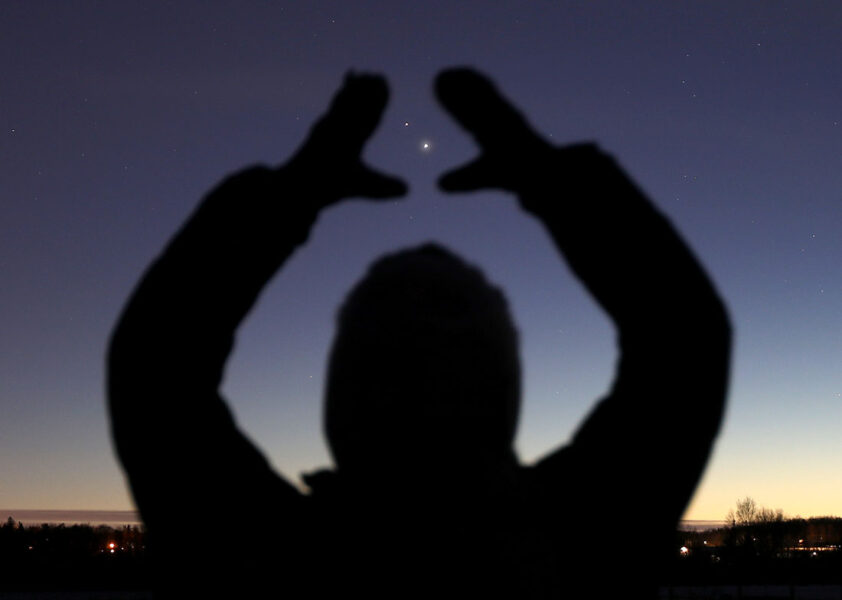
While we're all trying our best to keep our distance from one another during the current pandemic, Jupiter and Saturn are defiantly doing exactly the opposite. Since September they've been drawing closer and closer as they inch toward their Great Conjunction on Monday, December 21st. That night the gas giants will shine shoulder to shoulder just 0.1° apart (1/5th the apparent diameter of the full Moon) in their closest conjunction since July 1623.
Every 20 years, Jupiter, the closer and faster planet, laps slower Saturn and the two pair up briefly in a Great Conjunction. The last occurred on May 31, 2000, when they stood 1.2° apart low in the solar glare at dawn.
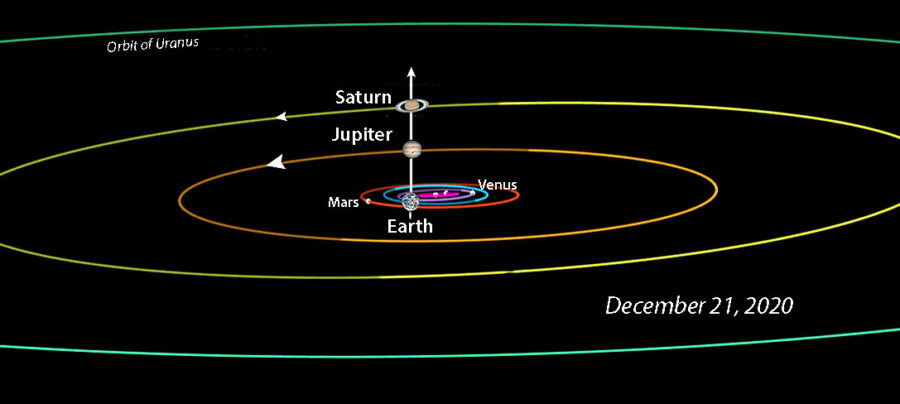
JPL Horizons with NASA images
Conjunctions between planets occur because they all lie in approximately the same plane, like runners on concentric tracks. As we look across the plane of the solar system, defined by Earth's orbit, one or more can appear along the same line of sight, similar to seeing an airplane momentarily pass near the Moon.
If the line were exact, Jupiter would pass directly in front of Saturn and occult it. But this rarely happens because both Jupiter's and Saturn's orbits are tilted slightly with respect to Earth's, by 1.3° and 2.5° respectively. The last near-central occultation occurred in 6857 BC and the next will be in AD 7541. At every Great Conjunction the orbital deck is reshuffled, with the apparent separations between the planets varying from near zero during an occultation up to a degree or more.
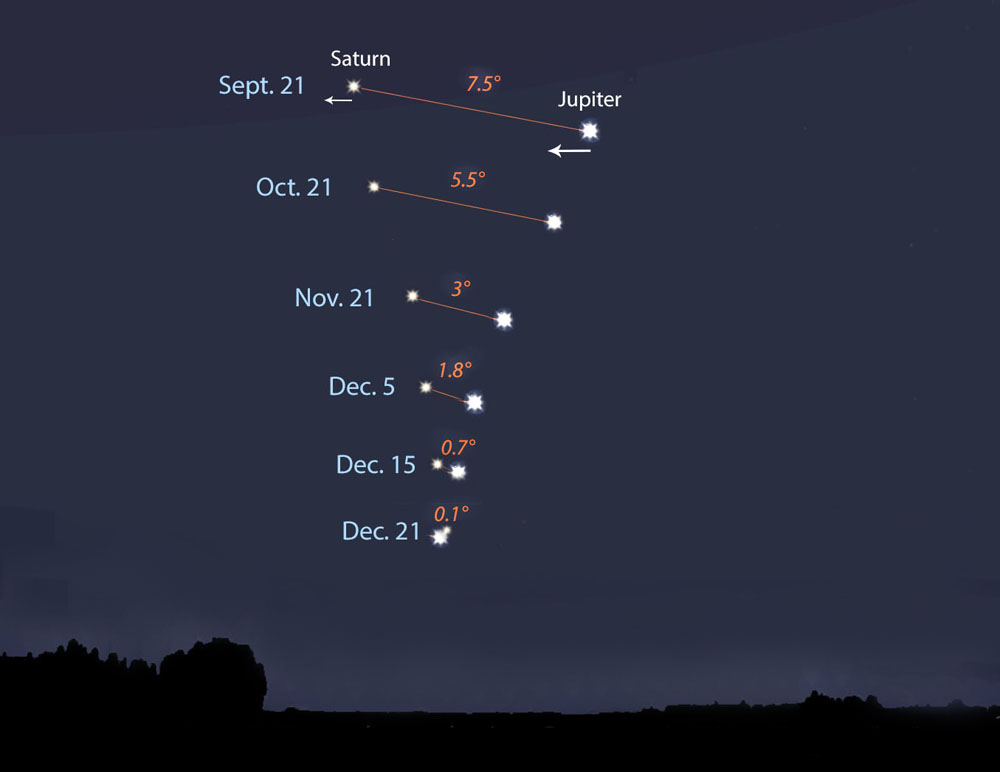
Stellarium with additions by the author
On the first day of fall, 7.5° or four fingers held together at arm's length, separated the two giants. On Monday, December 14th, they'll be 0.75° apart and close enough to fit together in a telescope's low-magnification field of view. Come December 21st, they'll scrunch nearly eight time closer — just 6.1′or 0.1° apart (center to center), closer than they've been in nearly 400 years! Closest approach occurs around 18h UT (1 p.m. EST). By the time the duo makes its appearance at dusk over the Americas their spread will have increased slightly to around 6.3′.
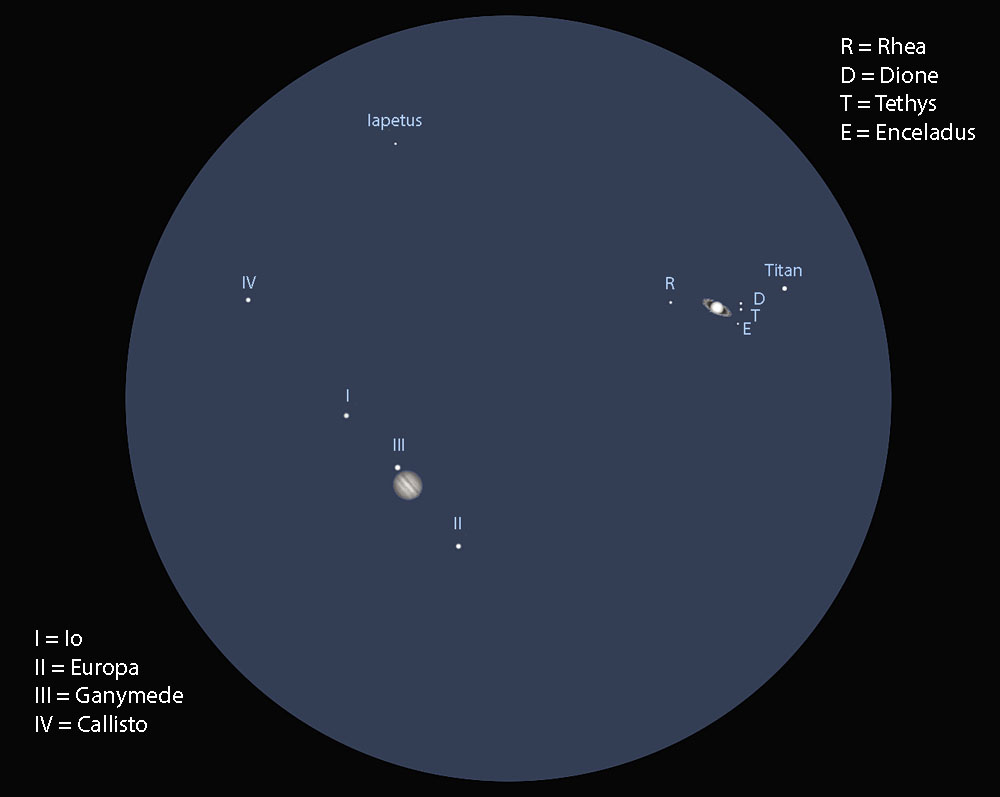
Stellarium
Adding to the festive occasion, all four of the Galilean moons will shine in a neat row on either side of Jupiter viewed from the eastern U.S. (three in the western states) along with several of Saturn's moons. Due to the pair's low altitude at the time everything may look a little fuzzy, so low magnification will provide the best views. The conjunction also happens on the winter solstice, which occurs earlier that day at 5:02 a.m. EST. Our cups runneth over.
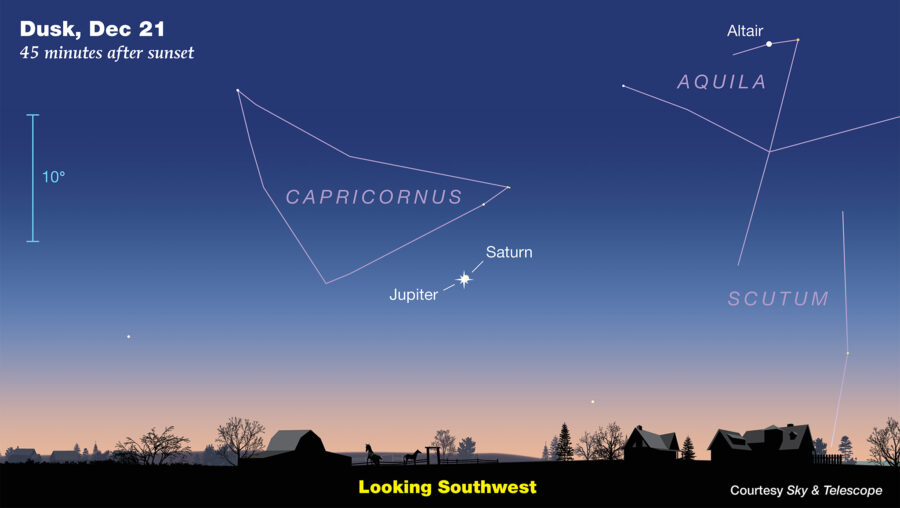
Sky & Telescope / Gregg Dinderman
Because Jupiter and Saturn will hang low in the southwestern sky, find a location with a wide open view in that direction. They'll be about 14° high when they first become easily visible about 45 minutes after sunset. The pair sets around 7 p.m. local time, so best not be late. Forty-five minutes to 90 minutes after sunset is the prime viewing window. Click here to find your local sunset time and plan accordingly.

Will you be able to separate the double planet without optical aid? You can get a sense of how small their separation will be by directing your gaze 10° (one balled fist at arm's length) above Jupiter. There you'll see the 4th-magnitude stars Alpha (α) and Beta (β) Capricorni in the constellation Capricornus. The upper star, named Algedi, is an "optical" double star — not a real, physical binary sun but two separate stars seen along the same line of sight.
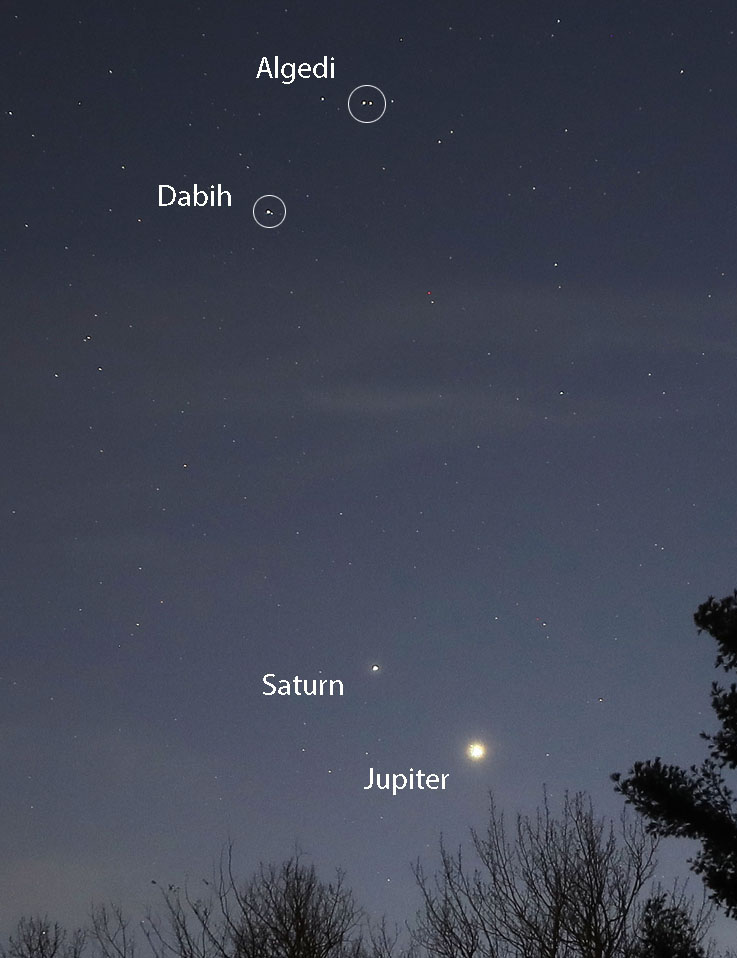
Bob King
Serendipitously, the pair is separated by 6.6′ (0.11°), nearly equal to Jupiter and Saturn's spacing on the 21st. Although Algedi's stars are fainter at magnitudes 3.6 and 4.4, I can split them (with concentration) into two separate, closely spaced points. Give it a try yourself the next clear night.
I'm curious if Jupiter's extra brilliance (magnitude –2) might cloak fainter Saturn (+0.6) in its glare. Jupiter will be obvious while Saturn should appear as a small bump. Will some observers need binoculars to split them? We'll just have to wait and see — bring along a pair just in case! Although the two planets will appear to nearly merge, Jupiter dominates. Adding Saturn to the mix will only increase their combined light by 9 percent, a barely noticeable amount.
Jupiter and Saturn Through History
On July 16, 1623, 5.2′ separated the pair, but with a solar elongation of less than 13° they set soon after the Sun does and would have been extremely difficult to view without optical aid. Telescopes were around at the time, so perhaps someone did see it, but if so, observational records have yet to surface.
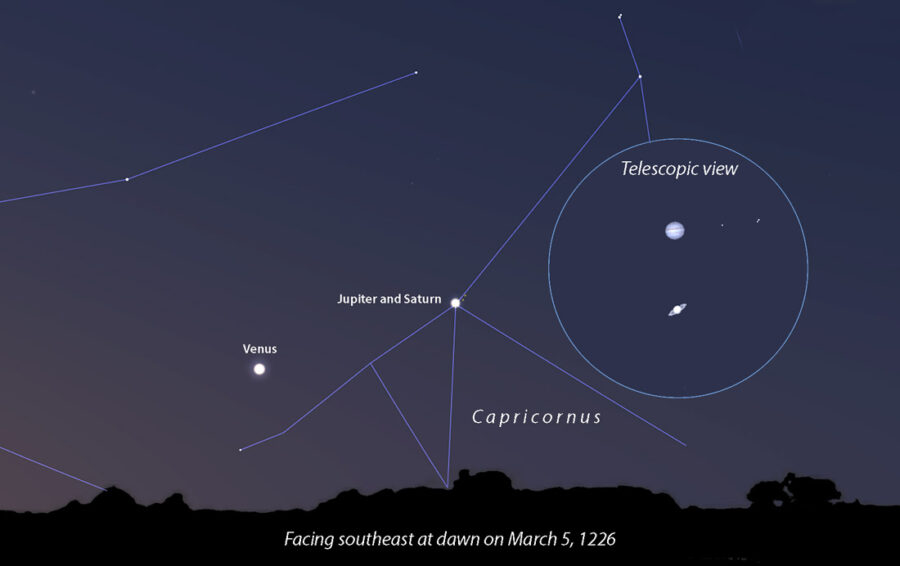
Stellarium
Jupiter and Saturn were nearly as close on August 25, 1563, at 6.8′ and easily observable in the morning sky. That would make this month's event the closest since 1563. But to find one closer we have to set our time machine chronometer to March 5, 1226, when the planets' separation tightened to just 2.1′. I like to imagine the people at the time watching the merger while describing the scene in archaic languages like Anglo-Norman and Middle English.
The next Great Conjunction occurs on November 4, 2040, at dawn with the planets separated by 1.2° in Virgo. To find an equal to the current event, we'll have to wait until March 15, 2080. That morning, the duo will be just 6.0′ apart in Capricornus at the start of dawn. Not until sometime after 2400 will we see Jupiter and Saturn approach so closely again.
For a detailed analysis of Great Conjunctions, orbital resonances, and much more visit Patrick Hartigan's Jupiter-Saturn Conjunction Series site.
A Christmas Star?
We often associate certain stars and constellations with the seasons or life events that have special meaning to us. It's inevitable then that some skywatchers will see the upcoming Great Conjunction as a modern version of the Christmas Star. More power to them. The Bible mentions that a bright star in the east heralded the birth of Christ. Assuming the description is more than symbolic, several explanations have been proposed for its origin, including a nova or supernova, comet, or a bright conjunction.
Based on available evidence the most likely event might be the strikingly close conjunction of Venus and Jupiter. On August 12th of the year 3 BC, the two brightest planets met at dawn in the eastern sky separated by 9′ as seen from Bethlehem. They were even closer together at dusk in the western sky on June 17 in 2 BC — just 1.4′ apart center to center — and would have appeared as a single brilliant "star." Scholars date Christ's birth as between 4 and 6 BC, though the date isn't definitive, leaving either conjunction as tasty food for thought.
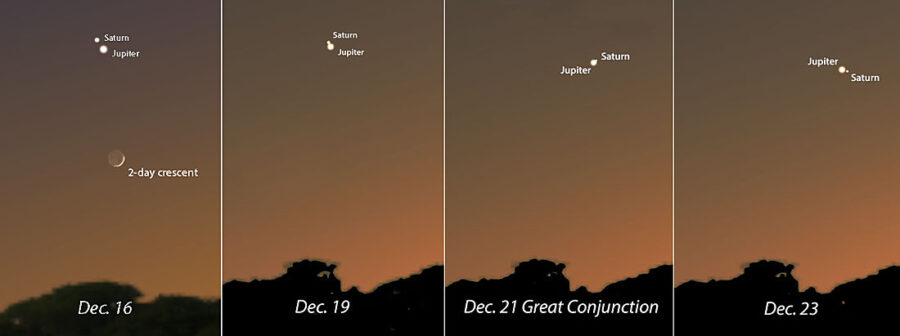
Stellarium
I encourage you to make your own connection with this rare celestial alignment. And if it's cloudy on December 21st don't take it too hard. Jupiter and Saturn will be wonderfully close from the 19th all the way to Christmas. Have a merry and inspirational holiday!
 53
53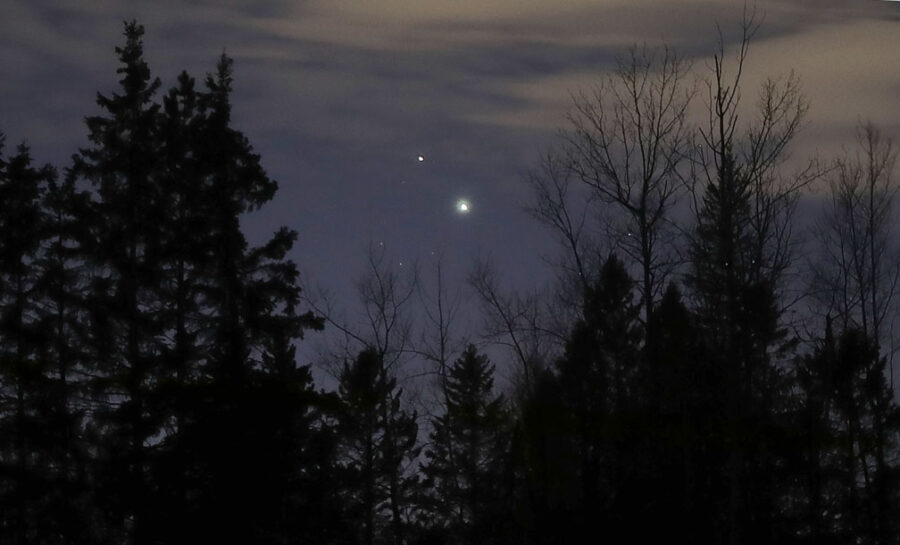










Comments
Rod
December 14, 2020 at 4:58 pm
Bob, thanks for the report here and charts. I posted some of my observations here https://skyandtelescope.org/observing/this-weeks-sky-at-a-glance-december-11-19-2/
In Maryland, I have been tracking and viewing since 07-Dec through last night. 10x50 binoculars and 90-mm refractor telescope. This celestial event is great fun to track and view. :)---Rod
You must be logged in to post a comment.
Bob KingPost Author
December 16, 2020 at 10:07 am
Thank you, Rod! Keep on posting. I saw them 2 nights ago and I have to say they really looked sweet. Very striking. I can't imagine how much more amazing they'll be soon.
You must be logged in to post a comment.
Devils tower
December 19, 2020 at 3:58 pm
http://www.sidc.be/silso/eisnplot
Has any one noticed how the daily sunspot number had a major peak after the max jup/sat/Sun alignment on 2 nov
You must be logged in to post a comment.
Bob KingPost Author
December 19, 2020 at 8:14 pm
Hi DT,
Thank you for writing. This would almost certainly be a coincidence. The combined gravitational effect of all the planets together in a line on the Earth (for instance) is much less than the effect of the Sun or the Moon on the Earth. Although some research shows that the tidal forces of the planets — particularly when Earth, Venus and Jupiter line up — can affect the sun's magnetic field, there's no one-to-one connection between a sunspot group outbreak and a planetary alignment. Jupiter-Saturn alignments would be even less effective because of distance.
You must be logged in to post a comment.
Andrew James
December 14, 2020 at 5:02 pm
Don't forget you can easily observe both planets during the daytime - even in small apertures. In the Americas close approach is at just after noon. Perfect.
Also on 25th at 02 50 UT finds all four Galilean satellites west of the plant joined by a 9.3v mag star, HD 191823 / TYC 6323-1760-1 . This will 'drift' by them over 2 hours or so. At 05h 11m UT it makes a very close approach to Europa, after being occultated by Jupiter at around 00h 18m UTC and emerging at 01h 09m UTC. By then, Jupiter and Saturn are 40′ arcmin apart.
Lastly, the astrologers have been going nuts, calling it "Great Conjunction." At least the Allure website claims: "As with everything in the stars, you have to do the work to get the most out of it, but if you buckle down and meet the cosmos halfway, the results are truly magical." The rest of the 'predictions' I disagree.
You must be logged in to post a comment.
Bob KingPost Author
December 16, 2020 at 10:06 am
Hi Andrew,
Thank you so much your viewing suggestion. I've seen Jupiter in the daytime although it's considerably fainter than Venus, but I've never seen Saturn. This will be the perfect opportunity.
You must be logged in to post a comment.
Peter Wilson
December 15, 2020 at 10:49 am
[ahem] It makes a nice headline, but the Biblical authors were not uneducated folk. They were familiar with basic astronomical terminology. The Magi were astrologers, who followed the planets diligently, and attached great significance to conjunctions. If the "bright star" had been a conjunction, they would have called it a conjunction. Period. If it had been a comet, they would have written that a bright comet appeared. A nova or supernova is the only plausible astronomical explanation for the appearance of a "bright star."
You must be logged in to post a comment.
Bob KingPost Author
December 16, 2020 at 10:21 am
Hi Peter,
I agree that a nova or supernova would have been the best explanation, but while there's a great deal of speculation, definitive evidence of a bright "new star" around that time is lacking. Whatever the magi really saw could have been corrupted later into a "star" or simplified (or idealized) as such. Even today, people will ask me what that bright "star" is in the western sky, and I'll explain it's Venus or Jupiter. During the June 17, 2 B.C. conjunction the two objects would have merged into a noticeably brighter single object that would have made a striking and memorable sight.
You must be logged in to post a comment.
Larry-Molnar
December 18, 2020 at 12:44 am
I think Peter is on the right track in noting the Magi were astrologers and that the Biblical authors were familiar with astronomical terminology. However, the reference to a "bright star" is incorrect. The passage mentions a star four times, but never modifies it regarding its brightness. There is an excellent book by Michael Molnar [no relation] that compares the Greek terms used to those used in Ptolemy's book on astrology, showing they were correctly used astronomical terms. This gets lost in English translations. For example, "star when it rose" should be "heliacal rising" and "until it stopped" refers to the transition between prograde and retrograde motion. The book can be found at https://www.rutgersuniversitypress.org/the-star-of-bethlehem/9780813564715
You must be logged in to post a comment.
Bob KingPost Author
December 18, 2020 at 1:16 am
Hi Larry,
Thank you for your comment. I wasn't aware of Mr. Molnar's research. After reading the information at the link, I replayed the eclipse of Jupiter by the moon on April 17, 6 BC Molnar proposed as the explanation for the "star". I discovered that both bodies were just 12.5° west of the Sun as viewed from Bethlehem at the time of eclipse, which began around noon local time. Also, the Moon's illumination was only 1.2 percent. These factors would have made the event impossible to see. I also have to point out that the moon didn't eclipse Jupiter as described but occulted it.
Nor was the pair "precisely in the east" as described at the link but high in the SW sky at an azimuth of ~211°. Earlier that day, the Sun rose about 5:32 a.m. in Bethlehem. Jupiter stood just 1° high 20 minutes before sunrise with the moon 2.5° away. I can't imagine anyone saw that either.
Maybe a visually-observable event wasn't as relevant to the Magi as knowing the eclipse would occur and its significance. Still, I can't help wondering about the reference to "seeing" a star in the east. Assuming it refers to a visual observation this event does not appear to fall into that category.
You must be logged in to post a comment.
Larry-Molnar
December 18, 2020 at 10:40 am
Hi Bob,
Points taken. The book is much better than the publicity blurb on the publisher's website (doubtless written by publicist and not the author). As described in the book, "in the east" is a poor translation of "heliacal rising", the first day on which an object that has been too close to the Sun to see is briefly visible in the east just before dawn.
The hypothesis presented in the book is that a set of cyclical events (of which Jupiter's heliacal rising is just one) occurred together in a distinctive way that point to a royal birth. None of these were visually striking by our standards. The real contribution Molnar makes is to go through Ptolemy's Tetrabiblos (which was a reference manual for astrological interpretation) and identify which events counted. Astrological interpretation is of course just a human construction, so the only way to know what would be striking to Magi is to consult a book summarizing their assumptions. Molnar found the events of 6 BC were a clean sweep of royal indicators that would occur together just once in a lifetime.
You must be logged in to post a comment.
Bob KingPost Author
December 18, 2020 at 12:51 pm
Hi Larry,
I agree. It would be nice to have the book at my side to really dig into his work. The occultation (invisible at the time) must have been a significant factor because if Jupiter alone were truly the star, its heliacal rising is visible every year and wouldn't be considered extraordinary. What's fascinating about the whole enterprise is that no matter how many important cyclical events are linked together, there is no evidence that astrology can predict current or future events on Earth then or now.
You must be logged in to post a comment.
Warren-Odom
December 19, 2020 at 8:20 pm
And here I always thought that "in the east" meant "while WE were IN (or toward) the east" since the Magi evidently had to come from that general direction.
You must be logged in to post a comment.
misha17
December 18, 2020 at 10:23 pm
There are only 2 Nativity stories in the 4 canonical Gospels, Luke's and Matthew's.
Luke doesn't mention when the Holy Family left Bethlehem, but they were in Jerusalem 40 days later for the traditional Purification ceremonies, then Luke wrote that they went to Nazareth. No mention of a flight to Egypt (as Matthew wrote after the Magi left), and it would not have fit into Luke's timeline, as Matthew had them residing in Egypt until Herod the Great died, ~then~ they went to directly to Nazareth, avoiding Jerusalem and King Herod's son and successor.
Matthew took a few liberties in his Gospel - his genealogy of Christ omitted several Kings to fit his "3 times 14 generations" narrative, and he mentioned that Christ's childhood in Nazareth fulfilled a non-existent "passage" from Scriptures ("He shall be called a Nazorean"). Christ's life was remarkable enough without the need for any extra embellishments.
You must be logged in to post a comment.
DBerry
December 23, 2020 at 6:04 pm
I agree that the Magi were astronomers, probably from Babylon. If the "star" was a planet or distant sun which they went towards - 12 hours later it would be behind them. So they'd be going back and forth, back and forth... And no one would call them Wise Men. 🙂
I believe it was a supernatural star that moved - leading them to Israel. After all it stopped over the house where the Messiah was. That would be a small miracle compared to the Creator coming to this tiny planet to live as one of his creatures.
You must be logged in to post a comment.
Luc
December 16, 2020 at 5:50 am
The last occultation of Saturn by Jupiter happened on 6857BC June 4, thus one year earlier.
There is a confusion with negative date value (-6856 06 04).
You must be logged in to post a comment.
Bob KingPost Author
December 16, 2020 at 10:01 am
Dear Luc,
Thank you for pointing this out. I wasn't aware that negative dates don't translate one-to-one to B.C. dates. Now I realize that in the negative dating system 1 B.C is numbered "0". This also explains a mystery. In the Stellarium star-charting program B.C. dates are given in negative numbers. While I rarely go back that far I now know why the negative number year differed from the B.C. value by one year. Thank you again, and the error has been corrected.
You must be logged in to post a comment.
Anthony Barreiro
December 18, 2020 at 11:23 pm
Well I'm glad we got *that* straightened out! Sherman nearly set the wayback machine for the wrong year. Mr. Peabody would not have approved.
You must be logged in to post a comment.
Bob KingPost Author
December 19, 2020 at 11:00 am
Thanks for the chuckle, Anthony. Much appreciated. I was and still am a big Mr. Peabody (Rocky and Bullwinkle) fan. On cloudy nights I wish there was such a thing as upsidaisium.
You must be logged in to post a comment.
Garry Stasiuk
December 16, 2020 at 3:44 pm
Howdy
I really enjoy your articles!
Having "lectured" in planetaria about the "Star of The Magi" since 1966, I have discovered the following, details about Kepler's method to determine great world events using "consecutive" great conjunctions of Jupiter and Saturn. You can find the details here...
https://uofgts.com/Magi.html
Thanks
Garry Stasiuk
You must be logged in to post a comment.
Bob KingPost Author
December 16, 2020 at 3:59 pm
Hi Garry,
Thank you very much 🙂 And the readers and I appreciate the link. I almost included the discussion of the triple conjunction of Jupiter and Saturn but because of length chose the brighter Jupiter-Venus events instead. But they certainly are another possibility.
You must be logged in to post a comment.
Rod
December 17, 2020 at 6:53 pm
Bob King et al. The sky tonight where I am at in MD - incredible show! Clear skies and temperature -01C or colder. A note from my stargazing log tonight tracking Saturn and Jupiter. [Observed 1645-1745 EST. Sunset 1647 EST/2147 UT. The December Sky & Telescope shows Io occultation this evening at 2213 UT/1713 EST. Io disappears behind Jupiter. I could see this in progress at 2206 UT/1706 EST at 71x. Io a small dot and bump on Jupiter's limb. Starry Night shows Saturn and Jupiter ~ 26' angular separation tonight. The waxing crescent Moon with earthshine, Saturn and Jupiter like two diamonds was an incredible view along ecliptic after sunset. I was able to see Saturn, rings, Titan, Io occultation in progress, Jupiter's cloud bands, and the other 3 Galilean moons tonight in the same FOV. Later after 1730 EST, some stars became visible in the FOV, this would make a lovely photo. The entire sky tonight with waxing crescent Moon, earthshine, Saturn and Jupiter like diamonds close to each other, was something to enjoy. 10x50 binoculars gave excellent views too.]
You must be logged in to post a comment.
New Jersey Eclipse Fan
December 18, 2020 at 4:12 pm
I REALLY like reading all the fascinating stuff. Keep it coming!
You must be logged in to post a comment.
drifterinthecosmos
December 19, 2020 at 1:26 am
Hi Bob,
I'm reader from Taiwan. I like all the articles you've written, they always gave me some new insight.
I wonder why the visible conjunction for Jupiter and Saturn often occur at or near by Capricorn? Is there any scientific explanation or just by coincidence?
I'm looking forward to receiving your reply and wishing you a happy weekend.
You must be logged in to post a comment.
Bob KingPost Author
December 19, 2020 at 11:28 am
Thank you for your kind words, drifterinthecosmos. Your question is an excellent one. I did some checking and discovered that Great Conjunctions occur primarily in Capricornus, Virgo and Taurus through 2199. The ones in Capricornus are closer conjunctions than the others. Then from 2219 through at least 2318, no conjunctions occur in Capricornus, with the primary locations shifting to Aquarius, Cancer, Gemini and Libra. I smell a resonance here and possibly grander cycles.
Large cycles were addressed in a wonderful article posted yesterday on the S&T site: https://skyandtelescope.org/astronomy-news/the-400-year-rhythm-of-great-conjunctions/ I also encourage you to read the Jupiter-Saturn Conjunction Series article at this link: https://sparky.rice.edu/~hartigan/public-night/jupsat2.html
You must be logged in to post a comment.
Rod
December 19, 2020 at 7:40 am
I agree New Jersey Eclipse Fan. After reading various posts here, some critical points need to be presented about the *Christmas star* :). Jesus came when Herod was still alive. Herod died in 4 BC. A lunar eclipse dates that year in Josephus writings and the battle of Actium dates Herod's death too. From my database "BAR continues to report more information on Herod's death. It certainly seems firm as 4 BC. Josephus record of Archelaus reign over Judea, when Caesar Augustus deposed Archelaus and the Battle of Actium all frame the year of Herod's death. Josephus shows that Caesar Augustus deposed Archelaus in his 37th year of reign after the Battle of Actium.", When Did Herod Die? And When Was Jesus Born?, BAR 40(5):11, 60, 2014 (September-October)"
Any dates for when Jesus was born showing after 4 BC will not work 🙂
You must be logged in to post a comment.
Rod
December 19, 2020 at 10:14 am
Here is an observation from me about the Christmas star reports I see popping up each year in December. It seems astronomers (at least some) like this story found in Matthew 2 so present it to the public like in planetarium shows, but commonly lack historical knowledge of the birth accounts of Jesus in Matthew and Luke or perhaps, just ignore the records as presented in the New Testament. The March 12-13 4 BC lunar eclipse of Josephus, Josephus Roman history and chronology for Herod and Archelaus, the references to Herod (9) in Matthew 2, Luke 1 (one reference in Luke 1:5), and reference to Archelaus in Matthew 2, all frame the time of Jesus Christ birth in Matthew and Luke in the New Testament. The historical witness provided is reliable and solid.
You must be logged in to post a comment.
Bob KingPost Author
December 19, 2020 at 11:04 am
Thanks, Rod for chiming in here. After reading your comments I'm not clear — are you suggesting the eclipse was the "star" seen by the Magi or are you using it to help frame the birth of Jesus?
You must be logged in to post a comment.
Rod
December 19, 2020 at 1:02 pm
Bob King, *using it to help frame the birth of Jesus* time, not define the lunar eclipse as the *star* seen (whatever that object was). Starry Night Pro Plus 8 has a simulation view of the Jerusalem lunar eclipse set for 12-13 March 4 B.C.E. starting at 0048 local time on 13 March. Matthew and Luke references to Herod, Herod's death, Archelaus, etc. place tight constraints on the time of events in Matthew 2 and Luke 1-2, this is evident when reviewing other ancient witnesses from that time period too, e.g. Josephus writings, e.g. lunar eclipse before Herod died and Roman chronology for Augustus, Herod, and Archelaus.
You must be logged in to post a comment.
New Jersey Eclipse Fan
December 20, 2020 at 2:35 am
Thanks for granting my wish for more stuff to read! I couldn't help but notice your (Rod's) usage of BCE. I was educated in a Jewish Day School from 1st-6th grades, where BC was NOT used, but rather the above abbreviation for Before the Common Era. CE is what I was taught to use instead of AD. When called for, we were also encouraged to write Merry Xmas. Which reminds me...I gotta send out cards to my friends who celebrate it!
You must be logged in to post a comment.
Bob KingPost Author
December 20, 2020 at 4:19 pm
Hi NJEF,
I let the editors decide on the preference BC vs. BCE. I chose BC, but I'm aware that BCE is also in common use. Your note also reminds me I better mail my Christmas cards tomorrow as well!
You must be logged in to post a comment.
Rod
December 20, 2020 at 9:00 am
New Jersey Eclipse Fan, hope you enjoyed Hanukkah earlier this month too. I am bad about sending out cards too :)---Rod
You must be logged in to post a comment.
New Jersey Eclipse Fan
December 20, 2020 at 9:30 pm
Well, I guess I'm not the only one, then! Thanks to both of you for your replies.
You must be logged in to post a comment.
Jim-Gasser
December 21, 2020 at 11:44 am
Surprised by clear skies in OH 5:45 pm to see the Great Conjunction! But clouds are predicted today.
In 8” SCT I could simultaneously see Jupiter and 4 Gallilean moons (plus a renegade star) and Saturn and her rings and moons Titan, Rhea, Dione. The star was so in line with the Galilean moons it looked like a 5th moon!
It was beautiful by naked eye, big binoculars, and the telescope. Marking my calendar for next time - March 15, 2080!
You must be logged in to post a comment.
New Jersey Eclipse Fan
December 21, 2020 at 12:54 pm
Geez--that's a month before my 121st birthday, so I probably won't be around for it. BTW cloudy skies predicted for tonight in NJ, too, but maybe it'll be clear along the southwestern horizon.
You must be logged in to post a comment.
Ravi Sadana
December 21, 2020 at 6:57 pm
Rob King,
Thank you for your effort to keep us posted on the progress of the great conjunction today. Nature is, in deed, beyond human comprehension, in most part. But physical matter and related phenomena offer us a great opportunity to observe some of her wonders. And you are pointing out a lineup of planets which is far away, but observable to the human naked eye.
Allow me to point out an other miracle much closer to us (sorry, not directly related to the topic at hand), that is, our body. Each and every cell in our body, although individually invisible to the naked eye, is a chemical factory of immeasurable proportions. The plasma, hormones, messenger molecules and other life-supporting (for want of a better word) chemical compounds it produces, at the right time and in the right amount, at the right place is, indeed, a miracle beyond human comprehension.
Thank you for educating us in astronomy. The reason I've stated the above is not out of context. If physical equivalents of all what a body does to "stay alive" were to be built by all the Engineers of all disciplines on Earth, they will need the whole universe to contain the production facilities. That's why the universe(subject of Astronomy) is so big and life so small.
This is not a religious statement, but a truly, scientific one.
Hope the editors won't dismiss my comment out of hand.
Ravi Sadana
You must be logged in to post a comment.
Bob KingPost Author
December 22, 2020 at 1:04 am
Hi again Ravi,
Your comment is well-taken. I think it's wonderful that you point out the incredible complexity of the human body. And to think it's just one example! Whether it's the body, the planets or the fabric of space itself, the universe is so rich in detail at every scale that I'm surprised sometimes that it's even comprehensible.
You must be logged in to post a comment.
Rod
December 21, 2020 at 6:58 pm
FYI folks. I was able to observe this Christmas star event. [Observed 1645-1740 EST. Sunset 1649 EST/2149 UT. I was able to view some of this very close conjunction tonight after sunset. Skies mostly clear but some altocumulus clouds from the west moved by in bands causing temporary masking or blocked views. I used my 90-mm refractor, 1.8x Barlow lens with 14-mm eyepiece. True FOV 33.6 arcminute angular size, Saturn and Jupiter about 6 arcminute apart. This was something to observe at 129x seeing both Jupiter and Saturn so close together in the eyepiece FOV. Cloud belts on Jupiter distinct, 3 Galilean moons on one side (Callisto, Io, Ganymede), Europa on the other side. My better views were from 1710 EST until 1740 EST before Saturn and Jupiter dipped below some trees in the SW. I did enjoy this event. Saturn rings and Titan visible. 10x50 binoculars provided excellent views too, both looked like diamonds close together in the sky, Jupiter the brighter member. Jupiter about 11x brighter than Saturn. Jupiter mv -1.97, Saturn mv +0.63 according to Stellarium 0.20.3. Hopefully some folks obtained photos. The view I enjoyed in the telescope eyepiece begged for good pictures. The 10x50 binocular view also was terrific.]
You must be logged in to post a comment.
Bob KingPost Author
December 22, 2020 at 1:06 am
Wow, Rod! Another excellent report. I agree. The pair looked like two diamonds in a ring. I was also quite surprised at how easy it was to separate them without optical aid.
You must be logged in to post a comment.
Ravi Sadana
December 21, 2020 at 9:08 pm
General comment re expressions.
We are talking about precise science matters, but the language to describe it is not precise. Jupiter and Saturn are not close to each other. They are aligned to the line of sight from Earth, that is, they are, for a very short time, one behind the other when viewed from Earth. They are still, millions and millions of kilometres away from each other, in their own orbits around the Sun.
Also it's abit of stretch to call them stars. They are planets and don't emit light of their own making. They are merely, mirrors. Thank you.
You must be logged in to post a comment.
Bob KingPost Author
December 22, 2020 at 1:00 am
Hello Ravi,
Thank you for writing. Indeed the planets are lined up but far apart. I think that's understood and the reason I included the solar system diagram showing how the two planets at different distances line up across our line of sight. But to the average person they do appear close to each other, so I think it's OK to use "close together" as shorthand because it's understood that it's appearance only.
You must be logged in to post a comment.
Donald Bruns
December 21, 2020 at 11:27 pm
I had clear weather in San Diego yesterday, and took some nice images about 50 minutes apart. I tried to make a stereo pair (crossed-eye technique) with Saturn in the background and Jupiter and four of its moons in the foreground. It didn't quite have the 3-D effect I was hoping for. Has anyone else tried this on their images? Maybe I need to do a little more processing to get a flatter background. I did stretch the image so the Galilean moons and Saturn were easy to see, with Jupiter just a white disk.
You must be logged in to post a comment.
Bob KingPost Author
December 22, 2020 at 1:05 am
Hi Donald,
Excellent idea. Please share the final result with us in a photo pair if you can.
You must be logged in to post a comment.
Donald Bruns
December 22, 2020 at 4:29 pm
I now have a photo pair that seems to work, in jpg. Where do I post it?
You must be logged in to post a comment.
Donald Bruns
December 22, 2020 at 9:46 pm
I've posted the stereo pair on my Facebook page under my name Don Bruns. The stereo effect is small, but the moons also appear 3D- albeit in the wrong direction!
You must be logged in to post a comment.
Bob KingPost Author
December 23, 2020 at 12:49 am
Excellent, Donald. I'm eager to take a look.
You must be logged in to post a comment.
Rod
December 22, 2020 at 9:08 am
Well, this report by Bob King is getting many hits 🙂 Ravi comments about Saturn and Jupiter being close is artistic license by me 🙂 Their closeness is relative to their position in the sky (angular separation), not physical distance. Consider the distance of Jupiter and Saturn last night when I could see both easily in the telescope view. Jupiter about 5.927 au from Earth, Saturn about 10.829 au (astronomical units). Starry Night Pro Plus 8 and Stellarium 0.20.3 provide distances from Earth for the event you are viewing. As I looked at both planets using my telescope, I thought I could throw a baseball at them and hit both of them, no problem :)----Rod
You must be logged in to post a comment.
Bob KingPost Author
December 22, 2020 at 8:01 pm
Rod,
Use a bat, and you'll get a double home run 🙂
You must be logged in to post a comment.
Ravi Sadana
December 23, 2020 at 4:04 am
Thank you, Rod, for your observations. The research scientist in me wants precision, but, vernacular artistic license is OK. The reading public doesn't care, one way or another.
You must be logged in to post a comment.
Rob_L.
December 22, 2020 at 6:57 pm
Just wanted to give kudos for a great article! I just came in from witnessing the great 2020 conjunction on a cold NJ night here in Toms River. Absolutely fantastic to view in 7 x 30 binoculars although the two planets are visible with the naked eye. I've posted several pics on Facebook. Thanks again for the article and accompanying pics.
You must be logged in to post a comment.
Bob KingPost Author
December 22, 2020 at 8:00 pm
Thanks RoJoLa! Very happy you got to see it. They were delicate and beautiful — and still are tonight.
You must be logged in to post a comment.
New Jersey Eclipse Fan
December 22, 2020 at 10:25 pm
If anyone cares, the cloudy skies prevented me from viewing the conjunction last night. Tonight, however, it cleared up just enough that I could view the two planets with my binoculars through breaks in the clouds. And I even managed to send out all of my Xmas cards!
You must be logged in to post a comment.
Bob KingPost Author
December 23, 2020 at 12:51 am
Way to go, NJEF! Dare I admit I haven't sent mine out yet? Tomorrow. Absolutely. Anyway, I'm glad you caught the planets. They were nearly as close tonight as on the 21st.
You must be logged in to post a comment.
You must be logged in to post a comment.